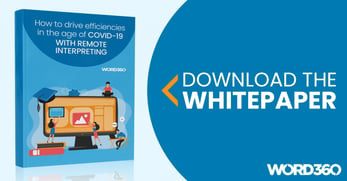How Much Does Interpreting Cost?

How much does interpreting cost? This is a question that’s asked a lot, and different people will tell you different things, but the only solid answer anyone honest can give you, as frustrating as it might seem at first, is “well … it depends!”.
Costs will vary based on what kind of interpreting you need and even what time of the day or night you need it. However, in this article we’re going to shed a little light on the cost of interpreting in its different guises and even help you understand which form of interpreting is most likely to save you time if you’re up against it. We’ll also discuss what’s the best form of interpreting, as well as the effect of the pandemic on all of this.
What’s the cheapest kind of interpreting?
Interpreting is charged by the length of time the interpreter is needed. This could be by the minute or by the hour, depending on what’s most practical. As some base rate indicators, here’s roughly what you’re looking at for the main three kinds of interpreting:
- Telephone interpreting: from £0.40 per minute
- Video interpreting: from £0.90 per minute
- Face-to-face interpreting: £25 per hour
Your cheapest form of interpreting then depends firstly on how long you’re going to need an interpreter. For example, a phone call will likely be more cost efficient if you’ll only need them for 10 or 15 minutes, but a face-to-face interpreter could be a better option if you’re likely to run into hours.
What’s the most time efficient form of interpreting?
The most traditional form of interpreting, face-to-face, requires an interpreter to be physically present. This means you’ll need to book them in advance, so they know where they need to be, when they need to be there, and roughly for how long.
The interpreter then needs to travel to and from the appointment and obviously physically attend it. This all takes time, and often will necessitate reimbursing the interpreter for their additional time and effort.
However, at the other end of the scale sits telephone interpreting. In Word360’s case, telephone interpreting requires you to do little more than pick up the phone, speak to one of our advisors and tell them which language you require as well as any additional factors such as a specific gender, and you’ll be connected in moments.
Your interpreter then remains on the phone with you for exactly as long as you need them, until their work is done and you hang up the phone; no travelling, no pre-booking, and so sign-in sheets.
What’s the best form of interpreting?
Again, this is a common question, but defining its answer is circumstantial. As a rule, we will often argue that face-to-face interpreting is the ‘gold standard’: it allows for maximum quality of communication, with facial expressions and body language that are so important for more complex or sensitive discussions.
However, this doesn’t necessarily mean that face-to-face is always the best form of interpreting. For example, a police officer may pull someone over at the side of the road who happens not to have a strong grasp of English. In order to communicate effectively with this person, the officer needs an interpreter, but it wouldn’t be ideal for them to have to wait for one to find them at the side of the road!
In this situation, the best form of interpreting is telephone or video interpreting, where the officer can simply make a phone call and be connected with an interpreter quickly and remotely, nowadays often through mobile apps such as Wordskii Live. The same can be said for many routine doctor’s appointments, where hiring a face-to-face interpreter for every 10-minute conversation regarding medication is simply not practical.
However, for some mental health assessments or sensitive conversations, using a telephone interpreter removes the empathy and compassion that is so important for these kinds of conversations.
There has been a significant shift to the use of remote video interpreting over the past year due to the pandemic, and this mode of interpreting offers a great in hybrid of telephone and face-to-face interpreting.
Offering convenience without losing the visual cues, expressions and connections, remote video interpreting has quickly become the nation’s favourite.
The answer to the question then, is that the best form of interpreting depends on your needs. At Word360, we provide remote video interpreting, telephone interpreting, and face-to-face interpreting, all of which are tailored to suit different needs.
You simply need to evaluate how long you’ll need your interpreter for, where you’ll need them, and how delicate or personal the conversation is.
The COVID-19 effect
The COVID-19 pandemic, although now hopefully in its final stages, has influenced the way this question is answered. Because this disease calls for social distancing as a control, the priorities for any given interpreting session have shifted.
Instances that would formally have involved a face-to-face interpreter don’t necessarily anymore. The reason behind this is two-sided.
On one hand, face-to-face interpreting now potentially involves a COVID-19 infection risk, making its use an exception rather than a rule.
On the other hand, the pandemic has forced the world as a whole into a more complete adoption of digital solutions, meaning that more people are comfortable with or even expect remote digital services.
In an article for Wired, Jacky Wright, chief digital officer at Microsoft, noted, for example, that 93% of primary healthcare care visits in England over the past year have taken place remotely.
These new additional health and cultural concerns will likely also need to factor into your evaluation when deciding which form of interpreting is best for you.
To understand more about how remote interpreting in particular can help drive efficiencies, download your free copy of our How to Drive Efficiencies in the Age of COVID-19 with Remote Interpreting whitepaper.

Elliot Glynn
May 4, 2023Related Services
.png?width=600&height=300&name=Untitled%20design%20(2).png)
Interpreting
Interpreting is where conversations are relayed from one language to another. How those conversations are conducted is where we add value. From in person meetings to remote video interpreting including British Sign Language, let us help you find the right solution.
.png?width=600&height=300&name=Untitled%20design%20(4).png)
Face to face Interpreting
Over half of communication is non-verbal or related to body language, which means face to face interpreters are experts at picking up on physical nuances which can alter the overall meaning of what is being said. Face to face interpreting therefore takes into account all physical and vocal elements of communication, delivering a truly accurate translation.
%20(300%20x%20150%20px).png?width=300&height=150&name=A%20picture%20containing%20text%20Description%20automatically%20generated%20(600%20x%20300%20px)%20(300%20x%20150%20px).png)
Interpreting
Many organisations are inadvertently turning d/Deaf customers and service users away by failing to provide them with basic access.
We cater to all languages and methods of communication and are proud to connect clients with dedicated BSL interpreters.
